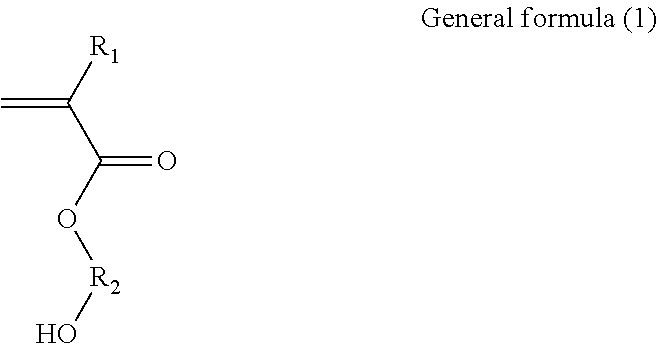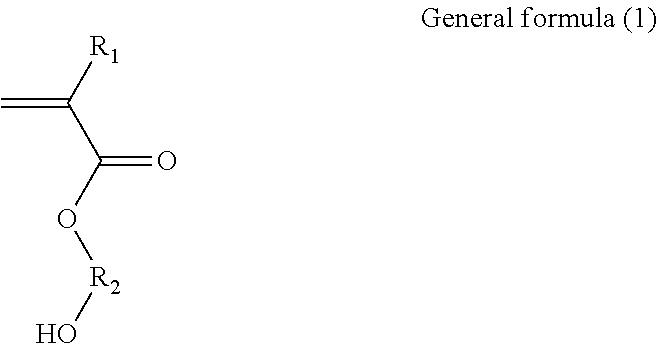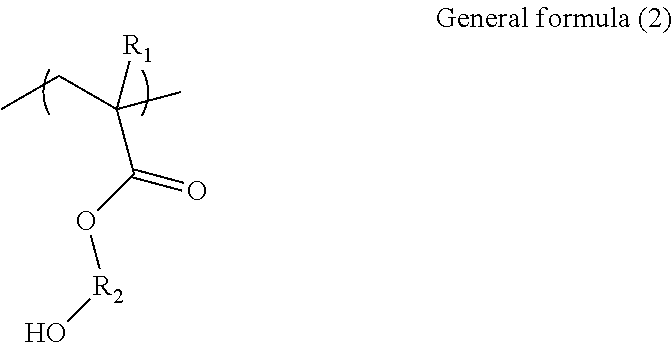Binder and aqueous solution
a technology of binders and aqueous solutions, applied in the field of binders, can solve the problems of insufficient storage stability of the binder, fiber or the like treated with the binder, etc., and achieve the effect of satisfactory strength and satisfactory storage stability
- Summary
- Abstract
- Description
- Claims
- Application Information
AI Technical Summary
Benefits of technology
Problems solved by technology
Method used
Image
Examples
production example 1
[0105]171.7 Grams of pure water was loaded (initial loading) into a SUS separable flask having a volume of 2.5 liters, the flask including a reflux condenser, a stirrer (paddle blade), and a temperature gauge, and its temperature was increased to its boiling point under stirring. Next, under stirring, 507.3 g (i.e., 5.64 mol) of an 80 mass % aqueous solution of acrylic acid (hereinafter referred to as “80% AA”) was dropped for 180 minutes into a polymerization reaction system in a boiling point reflux state, 366.4 g (i.e., 1.41 mol) of 50 mass % hydroxyethyl methacrylate (hereinafter referred to as “50% HEMA”) was dropped for 180 minutes thereinto, and 35.3 g of a 15 mass % aqueous solution of sodium persulfate (hereinafter referred to as “15% NaPS”) was dropped for 195 minutes thereinto. A 45 mass % aqueous solution of sodium hypophosphite (hereinafter referred to as “45% SHP”) was also dropped in two stages at the following supply rates thereinto under stirring: 24.3 g thereof was...
production example 2
[0106]127.6 Grams of pure water was loaded (initial loading) into a SUS separable flask having a volume of 2.5 liters, the flask including a reflux condenser, a stirrer (paddle blade), and a temperature gauge, and its temperature was increased to its boiling point under stirring. Next, under stirring, 610.6 g (i.e., 6.78 mol) of 80% AA was dropped for 180 minutes into a polymerization reaction system in a boiling point reflux state, 275.6 g (i.e., 1.70 mol) of 80% HEMA was dropped for 180 minutes thereinto, and 42.5 g of 15% NaPS was dropped for 195 minutes thereinto. 45% SHP was also dropped in two stages at the following supply rates thereinto under stirring: 29.2 g thereof was dropped for 18 minutes, and subsequently 114.5 g thereof was dropped for 162 minutes. The respective components were dropped from a tip nozzle through supply paths different from one another. Each of the components except the 45% SHP was continuously dropped at a constant dropping rate. After the completion...
production example 3
[0107]168.0 Grams of pure water was loaded (initial loading) into a SUS separable flask having a volume of 2.5 liters, the flask including a reflux condenser, a stirrer (paddle blade), and a temperature gauge, and its temperature was increased to its boiling point under stirring. Next, under stirring, 416.8 g (i.e., 4.63 mol) of 80% AA was dropped for 180 minutes into a polymerization reaction system in a boiling point reflux state and 23.2 g of 15% NaPS was dropped for 195 minutes thereinto. 45% SHP was also dropped in two stages at the following supply rates thereinto under stirring: 6.4 g thereof was dropped for 18 minutes, and subsequently 30.3 g thereof was dropped for 192 minutes. 92 Minutes after the initiation of polymerization, 119.1 g of pure water was dropped for 88 minutes thereinto under stirring. The respective components were dropped from a tip nozzle through supply paths different from one another. Each of the components except the 45% SHP was continuously dropped at...
PUM
| Property | Measurement | Unit |
|---|---|---|
| mol % | aaaaa | aaaaa |
| mol % | aaaaa | aaaaa |
| mol % | aaaaa | aaaaa |
Abstract
Description
Claims
Application Information
 Login to View More
Login to View More - R&D
- Intellectual Property
- Life Sciences
- Materials
- Tech Scout
- Unparalleled Data Quality
- Higher Quality Content
- 60% Fewer Hallucinations
Browse by: Latest US Patents, China's latest patents, Technical Efficacy Thesaurus, Application Domain, Technology Topic, Popular Technical Reports.
© 2025 PatSnap. All rights reserved.Legal|Privacy policy|Modern Slavery Act Transparency Statement|Sitemap|About US| Contact US: help@patsnap.com



